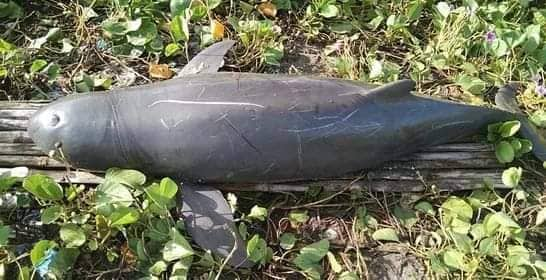
An Irrawaddy dolphin was found dead after being entangled in a crab net in waters off Calabanga town in Camarines Sur province on Tuesday. Photo by Nonie Enolva
LEGAZPI CITY — An endangered dolphin was found dead after being entangled in a crab net on Tuesday morning (August 16) in the waters off Calabanga town in Camarines Sur province.
Nonie Enolva, spokesperson of the Bureau of Fisheries and Aquatic Resources (BFAR) Bicol, said the female Irrawaddy dolphin was found by a fisher in Barangay (village) Bonot at around 3 a.m.
Enolva said it was the first Irrawaddy dolphin found in the Bicol region and the third in the Philippines.
“Dolphins need to surface for air, but when the Irrawaddy was entangled at the bottom, there was no chance to breathe because the body was already covered by the net,” she said.
She said the sub-adult dolphin weighed at least 100 kilograms and was 1.8 meters long.
The stranding site is located within the San Miguel Bay, facing the Pacific side and is north of the Bicol River basin.
The carcass was brought on Tuesday to the Central Bicol State University for Agriculture in Pili town for proper freezing.
On Wednesday afternoon, it was transported to the Marine Mammal Research and Stranding Laboratory of the University of the Philippines Institute of Environmental Science & Meteorology (UP IESM).
Enolva said the carcass would be used for the post-mortem examination, full morphometrics analysis and collection of samples for genetics in the Medical Management of Stranded Marine Mammals: Clinicopathologic, Diagnostic Imaging, and Necropsy Training at UP IESM on September 5 to 6.
In a report, the Philippine Marine Mammal Stranding Network (PMMSN) said the Irrawaddy dolphin is considered a critically endangered species under the International Union for Conservation of Nature’s Red List and the Department of Environment and Natural Resources Administrative Order 2014-15.
This species inhabits coastal areas, estuaries and rivers of the Bay of Bengal and Southeast Asia.
The only known population were at Malampaya Sound in Palawan and in the waters off Iloilo-Guimaras and Negros Occidental.
READ: Irrawaddy dolphins sighted in Negros Occidental coastal waters
“This is new evidence that we have this species in the Bicol region and a possible indication that they have been around for a long time but we cannot just see them. In Southeast Asia, there are less than 100 known populations,” Enolva added.
The PMMSN and BFAR Bicol were planning to conduct a marine mammal survey at San Miguel Bay.
Enolva appealed to the fishers to save the mammals if they encounter live stranding.
“During live stranding, fishers may sacrifice their fishing nets to release the mammals,” she added.